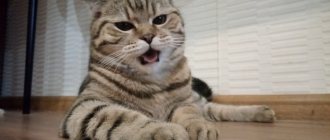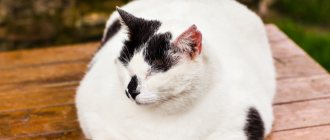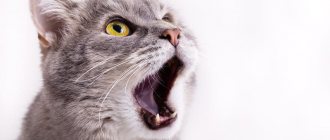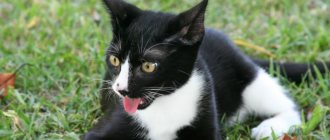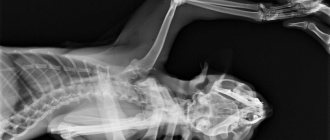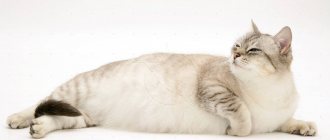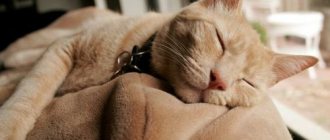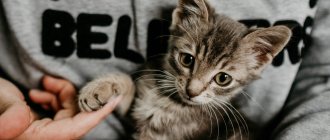Most people, noticing that the cat is breathing with its mouth open, smile, saying: “my cat now looks like a real dog.” However, they don’t even think about the fact that this could be one of the symptoms of a serious animal illness. The respiratory system of representatives of the cat family is designed in such a way that breathing with their mouths slightly open is unnatural for them, unlike dogs. Therefore, if the owner sees that his mustachioed pet opens its mouth while breathing, the first thing he needs to do is understand the reasons for such unnatural behavior.
Main causes of heavy breathing
The normal respiratory rate of tailed cats varies from 30 to 60 breaths per minute, with large and old cats inhaling less frequently than small and young cats. But there are situations when a pet’s breathing is disrupted.
Strange face of a cat
All the reasons why a cat breathes heavily and opens its mouth slightly are divided into physiological (they are not symptoms of the disease and depend on external influences) and pathological.
The first arise under the influence of several external factors:
- high air temperature indoors or outdoors;
- prolonged physical activity (active games, fast running, jumping), especially in animals suffering from obesity;
- emotional experience (joyful or, conversely, stressful state) of the animal.
For your information! If one of them occurs, soon after it is eliminated, the pet’s breathing will return to normal. In this case, you shouldn’t worry too much, but you still need to watch the cat for a while.
A cat's rapid breathing during pregnancy and childbirth will also be considered normal. The reason for this is hormonal changes in the body.
Respiratory system
If all of the above reasons do not apply, you need to urgently take the cat to see a veterinarian, most likely he is sick.
There are many different diseases that can cause a cat to breathe with its mouth open. The most common of them are:
- hypoxia;
- cardiovascular diseases;
- allergic reaction;
- oral diseases;
- respiratory dysfunction;
- entry of a foreign body into the respiratory tract;
- presence of helminthic infestations;
- rib fractures;
- drug poisoning;
- anemia.
Below are more details about the main ones.
Fever
In this case, the cat breathes like a dog, since this is the only way to escape the heat. The thing is that the furry body does not have sweat glands. When a cat exhales hot air and then fills its lungs with cool air, it cools down from the inside.
Note! If your pet has suffered heatstroke, you should not hesitate to provide first aid. You should put the cat in a cool place (for example, in the shade or on a cold tile), then gently wipe it with cold water or apply compresses and give a small amount of water. A mandatory step after the procedures is a visit to the veterinarian.
Joyful mood
When a pet is in a happy mood, its breathing quickens. A similar breathing failure occurs when the animal experiences severe fright or stress.
Hypoxia
Hypoxia is an insufficient amount of oxygen in the organs and tissues of the body. Oxygen starvation has two forms - acute and chronic. The first occurs due to massive bleeding, acute heart failure, thromboembolism, stroke or traumatic brain injury. The second is a result of abnormalities in the functioning of the respiratory and endocrine systems, as well as diseases of the liver and blood.
Heart failure
This disease makes itself felt immediately after the end of the animal’s active movement. In this case, the cat not only breathes like a dog, but accompanying symptoms appear: cyanosis of the tongue, severe shortness of breath and cough. There are times when the patient begins to foam from the nose and mouth.
Note! There is a breed predisposition to heart disease. Often, these ailments affect cat breeds such as Maine Coon, Oriental, Sphynx, and Scottish Fold.
The most dangerous heart pathology for a kitten is hypertrophic cardiomyopathy. It is difficult to detect in the initial stages, since owners often mistake the first symptoms of the disease, such as long periods of sleep, inactivity and avoidance of play, with the breed characteristics of the animal.
For your information! The acute form of the disease leads to pulmonary edema. The animal dies almost instantly.
Allergy
Cats, like people, can experience allergic reactions. Often, with acute allergies, they experience heavy breathing. In this case, the mustachioed’s breathing becomes shallow, accompanied by a dry cough with a paroxysmal character.
For your information! In medicine, rapid shallow breathing in both humans and animals is known as tachypnea. It is also called "breath of the hunted beast."
When a cat has tachypnea, he often sneezes, this indicates that a foreign object has entered his nose. Clear snot may flow from the nose, and tears may appear from the eyes. If a foreign body gets into the kitten's throat, in addition to difficulty breathing, there will be severe salivation. Sometimes the unfortunate animal develops gag reflexes, difficulty swallowing, and may wheeze.
When infected with lungworms, a cat will not only open its mouth and breathe frequently, but also lie down most of the time, refusing not only to run, but also to walk. Such a pet has a dry cough, as well as deep shortness of breath.
Rib fractures and various spinal injuries also lead to abnormal breathing. The animal, gasping for air, tries not to use the chest and breathes with its stomach. Associated symptoms are shortness of breath and acute pain, increased heart rate, the presence of bruises and wounds, and a constant desire to sleep.
If a cat suddenly accidentally swallows medications or household chemicals that are dangerous to his health, his breathing will likely become difficult, he will begin to drool, his pulse will be impaired, and vomiting and diarrhea will begin.
Progressive anemia is a dangerous disease that occurs due to a drop in hemoglobin levels in the blood. The pet opens its mouth while breathing, and also gets tired quickly, is constantly cold, refuses to eat, and sits absolutely indifferent.
Heat
The main physiological reason why a cat sticks out its tongue is temperature regulation. The animal protrudes the organ to reduce discomfort, for example, during heat. This prevents the development of heat stroke. In this case, the owner should take the cat to a cool place and pour water on it.
But a cat's tongue sticking out can also be a signal of high body temperature. To understand whether your pet is suffering from heat or is sick, you need to figure out what temperature is considered normal in cats.
The normal temperature for a cat is 38-39 degrees. But don’t panic right away if the indicator deviates slightly from the norm. Here are the common reasons for the thermometer to shift:
- immediately after sleep, the thermometer drops by a couple of divisions;
- in the evening the cat’s body temperature will be higher than in the morning;
- Kittens have a slightly higher temperature than adult animals.
Animal Treatment Options
In most cases, the best option would be to urgently hospitalize your furry. There is no need to try to cure a tailed cat at home. By trying to help the poor cat on their own, the owners are only stalling for time and making the situation worse.
After giving birth, a cat often breathes with its mouth open
Contacting a veterinarian
When contacting a veterinary clinic with complaints of unnatural breathing of a pet, the doctor will prescribe the following tests:
- ECG of the heart;
- Ultrasound of the heart;
- blood test (general, biochemistry, for infections: herpes, rhinotracheitis, etc.);
- fluoroscopy;
- consultation with veterinarians: oncologist, dentist and surgeon;
- bronchoscopy;
- rhinoscopy.
The list of studies is impressive, but despite this, loving and responsible owners will do everything necessary to ensure that the four-legged disease is diagnosed on time. This will increase the chances of a speedy recovery for your pet and its return to its former carefree cat life. Therefore, at the slightest suspicion of illness in your tailed friend, you must call a doctor at home or take the cat to the hospital.
Note! An exception is if a foreign body enters the nasopharynx. In this case, you need to save your pet very quickly. If you know the sequence of actions, even a person without a medical diploma can help an animal.
If a foreign object is stuck in your pet's nose, to provide first aid you need to open the cat's mouth wide, then pull his tongue and try to stick the object out with tweezers. If he ends up in the trachea, you need to follow these steps: turn the cat over, then lift him by the hind legs and gently press his stomach in the diaphragm area. After such manipulations, the foreign object should jump out. But if this does not happen, the cat must be urgently transported to the veterinary clinic.
Symptomatic diet and procedures
If the cat is pregnant or has just taken a ride on public transport, its breathing disorder is temporary. In this case, she does not require treatment. It is enough to drop a couple of drops of valerian or motherwort, and the animal will calm down.
If the animal is wheezing and breathing through its mouth, you can try to independently examine its nasopharynx. Perhaps a foreign object got there. It should be removed. You can try to grab the animal by the hind legs and turn it upside down. In this position, the cat needs to be gently but confidently shaken 2-3 times.
It happens that a foreign object sticks to the larynx. Getting it becomes a problematic task. To do this, you need to restrain the cat, literally swaddle it and thereby immobilize it. You need to open the cat's mouth, illuminate it with a flashlight and try to remove the foreign body.
If the cat is not breathing, it is recommended to perform closed cardiac massage and perform artificial respiration. To do this, the cat is placed on its back and fixed so that the neck and spine are in line. The animal's mouth should be closed and air should be blown through the nose. To do this, the palm is rolled into a tube, placed against the nose and air is blown in at a frequency of 20 blows per minute. At the same time, external cardiac massage is performed. To carry out a massage, the animal’s chest is pinched with your hands: thumbs on the chest, the remaining fingers on the back, then squeezing and unclenching movements are made.
Alarming symptoms
If the cat is healthy and breathes with a half-open mouth during extreme heat outdoors or indoors, after long active games, as well as during periods of emotional distress, other alarming symptoms will not appear. At the same time, the pet’s tousled fur, enlarged pupils and “pistol tail” do not count. They only confirm that the cat is worried about something, tired, etc. Very soon everything will pass, and he will breathe through his nose again.
The dog breathes frequently and heavily with his mouth open and his tongue hanging out
If there is pathology, there are accompanying symptoms.
Alarming symptoms
Signs indicating the need for medical care for an animal include:
- rapid breathing with the mouth slightly open, abdominal inhalation;
- hoarseness, unusual for a cat;
- loss of appetite;
- decreased activity, apathetic state;
- vomiting, cough;
- unnatural posture;
- anxiety and fear;
- strong thirst;
- change in color of the mucous membrane (pallor, cyanosis).
Note! If any of the symptoms appear after the pet has exercised, it must be urgently sent to a veterinary clinic.
Thus, when a cat sticks out its tongue and breathes frequently, this is an alarm bell for every owner. The frequency of respiratory movements does not always return to normal without outside help; often this behavior of a four-legged pet is a sign of many serious diseases that require immediate attention from a veterinarian. The owner will do a great service to his pet if he pays attention to the mustachioed’s abnormal breathing in time and begins to act.
Video
IMPORTANT: if the kitten always walks with his tongue sticking out
..., but no symptoms are detected, show the baby to the veterinarian.
Perhaps your cat has an incorrect bite, and then it is very important to monitor the cat’s drinking, because you cannot allow the tissues of the tip of the tongue to dry out
An adult cat can sometimes “freeze” when washing itself. Distracted by something more interesting than hygiene, an adult cat may forget to remove his tongue
This usually doesn’t last long, the cat will either continue to wash itself or go look at the reason that distracted its attention.
Also, an adult cat in the heat or after active games and activities can fall asleep like a kitten with the tip of its tongue slightly sticking out. This is how the animal cools the blood through external cooling of the tongue and saturates it with oxygen spent on activity. Therefore, if a cat sleeps with its tongue hanging out and does not drool or foam, there is no need to worry.
